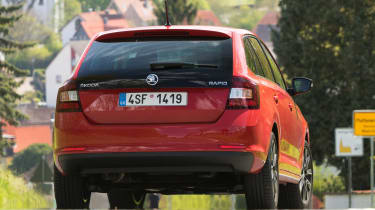Skoda Rapid Spaceback hatchback (2013-2019) - Engines, drive & performance
The Skoda Rapid Spaceback has impressive engines, but its driving experience is less so
The engines for the Skoda Rapid Spaceback are geared more towards efficiency than excitement, yet none is drastically underpowered. You’ll need to decide which offers the right balance between power and economy for your needs – but they all have something to recommend them.
From behind the wheel, the Rapid Spaceback handles tidily and competently without ever being exciting. It offers a quiet ride and feels securely planted to the road, but is never very involving to drive – the steering lacks feel and isn't especially responsive and the suspension doesn't keep the car's body under tight enough control for enthusiastic drivers.
The Renault Megane and Ford Focus both provide a more enjoyable driving experience, while the Volkswagen Golf offers a better blend of engaging road manners and comfortable ride. However, all those rivals are more expensive to buy than the Spaceback.
Skoda Rapid Spaceback petrol engines
The petrol-engined Spacebacks are the least expensive to buy and look like good value.Of the two 1.0-litre, three-cylinder engines, the more powerful version is our favourite. Not only does it perform better when you head out of town, it importantly comes with a six-speed manual gearbox instead of the five-speed of the 94bhp model, making it a better motorway car for a relatively small additional cost.
The entry-level 1.0-litre is also available with a DSG seven-speed automatic gearbox, but it doesn’t feel like a great match with this engine, often changing gears at the wrong time and in a rather jerky fashion. We’d stick with the manual unless you have no other option.
Diesel engines
Those who are likely to spend a lot longer behind the wheel, regularly covering long distances on the motorway and racking up more than 12,000 miles a year, would be wise to consider one of the diesel engines: a 1.4-litre, 89bhp three-cylinder or a 1.6-litre 114bhp four-cylinder.
The former combines 70.6mpg fuel economy with a 0-62mph time of 11.2 seconds, while the latter drops that time to 9.6 seconds, without economy suffering too badly. The larger engine is also notably smoother thanks to its increased cylinder count, but it does grow quite noisy when cruising on the motorway. The petrol engines make for a more peaceful car to travel in on long journeys.












